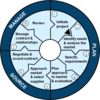 Phil Weir initiated and led procurement reform for the New Zealand government. In this month’s SmartProcurement he shares how his department developed efficiencies in 350 government agencies that expend NZ$20-billion.
Phil Weir initiated and led procurement reform for the New Zealand government. In this month’s SmartProcurement he shares how his department developed efficiencies in 350 government agencies that expend NZ$20-billion.
However, if you’re expecting a complex recipe for public procurement soufflé you will be disappointed. “The key lesson,” says Weir, “is that developing efficiencies across government and in your own department is accomplished by getting the procurement basics right.”
Fundamentally, Weir’s perspective on procurement is that it has a wider scope than purchasing: it is not just acquiring goods and services that fulfil end users’ requirements at a reduced total cost of ownership, rather “it covers the planning and the optimisation of sourcing activities and involvement in the supply-demand markets”.
It was with such a perspective that Weir’s team approached the imperative issues created by the existing procurement governance structures (see side bar) that had to be addressed under the new methods. Image restoration being one of them.
“Some high-profile, but failed procurement projects necessitated the restoration of the public’s perception that their tax-payer dollars secure value for money,” says Weir.
Added to this were the typical procurement goals of long-term cost containment; and requiring purchasers to stimulate strong supplier performance.
The basics of good practice
 Weir’s team “applied good basic practice to each department and all-of government”. Good basic practice is encapsulated in the procurement lifecycle alongside, and is a process of planning, sourcing and managing the procurement process.
Weir’s team “applied good basic practice to each department and all-of government”. Good basic practice is encapsulated in the procurement lifecycle alongside, and is a process of planning, sourcing and managing the procurement process.
However, the team realised that they would structure a procurement approach that was not traditional.
A traditional approach sees procurement adding significant value when approaching the market and selecting a supplier; negotiating and awarding a contract; and managing the contract and relationship. The traditional approach does not recognise procurements ability to add value in the remaining steps of the procurement lifecycle.
![]() On the other hand a strategic approach sees procurement adding value throughout the purchasing process, a great deal of value when initiating the project and identifying the need; declining when approaching the market and swelling again when managing contracts and relationships and under contract review.
On the other hand a strategic approach sees procurement adding value throughout the purchasing process, a great deal of value when initiating the project and identifying the need; declining when approaching the market and swelling again when managing contracts and relationships and under contract review.
Interestingly, the areas in which procurement was perceived to add the greatest deal of value in the traditional approach were in fact the areas where procurement added far less value overall when taking a strategic approach.
Leading with a ‘strategic view of the procurement function’ Weir’s team successfully reformed four themes within the New Zealand government’s procurement:
1) Creating cost savings.
2) Building the capacity and capability of procurers.
3) Enhancing the participation of New Zealand business in the process.
4) Improving governance, oversight and accountability within processes.
The procurement landscape that Weir’s team sought to reform:
• A lack of process consistency and a wide variation between best and worst practice.
• Departments paying significantly different prices for the same items.
• No arrangement for managing suppliers across government – again, suppliers enjoying differential pricing.
• No common process for managing large, complex procurements.
• No common systems across government recording what is being purchased, prices and from whom; and targeting and measuring year-on-year value for money improvements.
• Overall skills levels amongst purchasers insufficient.
• Although procurement is fair and open, concerns existed about bidding costs.
Phil Weir has worked in private and public sector procurement. He holds the title of FCIPS. Contact him at philip.weir@adaa.abudhabi.ae


























